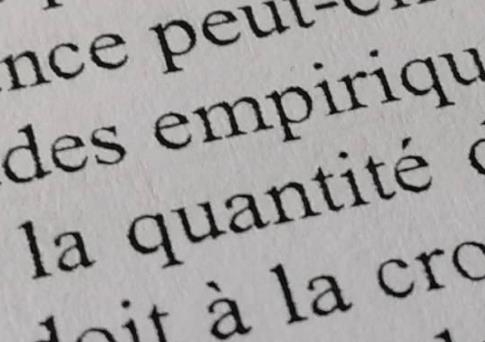The 10 basic pronunciation rules for learning French online
In previous articles, we have talked about French vocabulary, grammar and even the most basic expressions you should know. Today we are here to explain another of the most important concepts when learning a new language such as French. We are talking about pronunciation and the complex rules that govern this part of the language.
But before we go on to talk about the concepts you need to keep in mind when speaking French, we are going to give you the best advice. Sign up for Classgap and book an online French class. Discover all the advantages of online training with a French teacher. Remember that on our platform you can choose whether you prefer a native or a bilingual teacher. Are you still here? Run and sign up now on Classgap. Once you have done so, discover the 10 basic rules of French pronunciation.
Rule 1 of French: the 'E'
A letter that can cause problems, as it has 2 different pronunciations. With a grave accent (è), circumflex (ê) or acute accent (é), it is pronounced in a similar way to the Spanish 'E' ('Mère', 'Fête'...); with a grave accent, the pronunciation must be more open, whereas with an acute accent it is more closed. On the other hand, without an accent, it is silent at the end of a word ('Porte'), while at the beginning or in the middle it sounds like a mixture of 'E' and 'O'. And these are just a few of the peculiarities of this letter! What do you think of the peculiarities of French?

Rule 2 of French: the 'C'
Pay attention to what we are going to tell you about the letter 'C'. When it comes before the 'E' or the 'I' (or when it has a cedilla 'Ç'), it sounds like an 'S'. The same rule applies to 'Z'. Likewise, the combination 'CH' has a softer sound and should be pronounced like the English 'SH'. That is, except when it precedes 'L', 'N' and 'R'. In those cases it should be treated as a 'K'. The same goes for 'J'. Things are getting more complicated... and we are only at rule number 2.
Rule 3 of French: the 'R'
If you've ever tried to imitate the French accent, you've probably pronounced their 'R' as if it were a 'G'. Let us congratulate you, because that's how it should be pronounced. It's hard to believe that by doing an imitation of French, you have passed the third rule of the language. Keep it up, you'll soon become an expert in French.

Rule 4 of French: the 'G'
When it comes before the 'E' and the 'I', it is completely transformed and takes on the sound of the French 'J'. Along the same lines, the form 'GN' is pronounced like the most typical letter in Spain: the 'Ñ'. A clear example would be 'Espagnol'. This one was easier, wasn't it?
French Rule 5: 'PH'
This commandment is very easy to learn and memorise. You just have to remember that this combination has to be pronounced like the letter 'F' ('Philosophie', 'Photographie'...). As you can see, it's just as easy as with English, you'll master this one in two days! Learning French online is easier than it looks, so don't be afraid and book a French lesson online.

Rule 6 of French: the vowels
Although we have already talked about the 'E' and its multiple personalities in the French language, the truth is that when speaking French, you must pay attention to all the vowels. And there is nothing better than learning their sound. If you thought that 'E' was going to be the only complicated letter, you were wrong. O', 'AU' and 'EAU' are pronounced like the vowel 'O' ('Eau', 'Beau'...), while the combination 'OU' has the sound of 'U' ('Moule', 'Vouloir'...); and the latter has to be pronounced like an 'I', but with your lips as if you were going to say 'U'. OI' must be articulated as 'UA' ('Poisson', 'Moi'...), and 'EU' and 'OEU' as if you were trying to pronounce 'E' and 'U' at the same time ('Peur', 'Coeur'>...). Special mention should be made of vowels followed by 'M' or 'N', which should sound as if you had a stuffy nose.
Is that clear to you? You have to work on it little by little and the best way to master it is with an online French teacher. Book your French class online at Classgap and discover the advantages of learning French online with a native French teacher.
Discover the advantages of learning french online
French rule 7: endings
Most 'E' and 'S' are not pronounced. Moreover, the latter must be pronounced like the English 'S', except when it is between vowels, as it has to be pronounced with a greater sonority. Likewise, the ending '-ENT', belonging to the third person plural of some verb tenses, is also silent ('Parlent'). And some consonants too! It seems that the French make it difficult to learn their language. We are sure that with a few online French lessons, you will master the French language in no time.

Rule 8 of French: the diaeresis
The dieresis is used to destroy vowel combinations, so that each vowel is part of a different syllable and must be sounded independently. ('Héroïque', /ero-ïk/). This one was simpler, wasn't it? It's not all about complicated rules, there are also some simpler ones that we can easily learn.
Learn French online at Classgap
Rule 9 of French: acute words
In French, all words are acute, and therefore the stress falls on the last syllable. In this case, the French are less complicated than the Spanish, although there are some exceptions. As we have already said, if words end in 'E', this should not be pronounced, so the stress falls on the preceding vowel. This also includes even those words that have been modified by verb endings and the plural form ('Aventures', 'Elles chantent'...).

Rule 10 of French: "La liaison"
This is what is known in French for words that join their last syllable with the first syllable of the following word. In this case they must be pronounced as if they were a single word. This happens when one word ends in a consonant or 'silent E', and the next begins with a vowel or 'H' (which is also usually silent). Thus, 'Les amis' would sound like 'Lesami' (as we said, the final 'S' is not vocalised). To master this rule, all you have to do is talk, talk, talk! So your only option is to book an online French lesson on Classgap. Don't worry, we are here to help you!
Online French lessons at Classgap
You've probably tried many methods to learn French. A mobile app, watching series in V.O., listening to music or podcasts... but none of these activities are effective if you don't complement them with a more effective method. Online French classes are the best basis for learning French. Sign up for Classgap and find the best French teacher for you. How? Very simple, here are some tips to help you make the best possible choice:
- Set your goals: you must be clear about your reasons for starting to study French. You should also know what level you are at and how far you want to go with online French classes.
- Organise your time: the greatest advantage of online classes is the possibility of combining your training with other activities. You choose the day and time of the class and filter the available teachers.
- Choose the price: you can filter according to the budget you have for online classes and select the French teacher according to your financial possibilities.
- Choose the best learning method: you can book a 20-minute lesson to get to know each other and to establish a methodology for your online French lessons.
Among many other advantages, online classes do not take up as much of your time as face-to-face classes, as you avoid having to travel (which not only involves moving from one place to another, but also getting ready to leave the house, wasting time with the next door neighbour, etc.). Moreover, by avoiding the cost of such transport, the price per class is reduced, ranging from €10 to €25 on average. So, the two main excuses are cancelled out with online tutoring.
Now that you know how to choose the best teacher for you, it's time to book a lesson. Here are the steps you need to follow:
- Sign up for Classgap
- Access the French teacher list
- Filter the search according to your needs, choose whether you want a native or bilingual teacher.
- Set the time you are available to take the class and enjoy the flexibility of the timetable
- Set the maximum price you want to spend
- Visit the teacher's profile, their personal details and their video presentation
- Read the comments and recommendations from other users
- And, if you are convinced by one of our teachers, book a class.

Learn with Classgap and enjoy all the advantages of learning French online. Find the teacher you like best and book a 20-minute free trial with him/her to get to know each other. Introduce yourself and explain what your goals are, he/she can help you achieve them, so what are you waiting for? Get started today!
